The Summer 2010 Anime Preview Guide
Gia Manry
by Gia Manry,
Gia may refer to any of the following: the Gemological Institute of America, Glasgow International Airport, Garuda Indonesia, and/or the associate editor of Anime News Network.

Shiki
Rating:
It's a gothy horror show, but at least the OP isn't Ali Project!
Megumi, a budding 10th-grade gothic lolita, is desperate to make her way out of her boring farming village and move on to Tokyo. Even the mildly mysterious deaths of three elderly villagers do nothing to spark her interest. Nothing does, really, except the idea of living in Tokyo- and the European-style mansion on the hill with its strange new occupants. It is in the name of meeting these people that Megumi finds herself in front of the mansion...and then goes inexplicably missing.
As far as a horror mystery goes, Shiki's first episode does a pretty decent job of setting something up without being too vague to make it interesting or too specific to make it mysterious. The animation is solid and the voice-acting appropriate- for now; we haven't yet heard Gackt's appearance as the son of the mysterious mansion household.
Quite a few other characters are introduced in this first episode, though, a couple of whom show up only once briefly. Since picking up their names and titles requires reading quickly, you may want to pause or watch twice, although it's not impossible to catch the first time through if you're paying attention. Hopefully later episodes will return these characters in a context that makes them easy to remember.
What stood out about Shiki was that no one who was introduced- from Megumi's would-be friend to the doctor to the priest to the boy Megumi has a crush on -seems like a throwaway or a one-note so far, everyone has the possibility of developing.
A solid and promising, albeit not outstanding, start for Shiki.
Shiki is available streaming at Funimation

Moyashimon (Live-Action)
Rating:
Having read the first volume of the Moyashimon manga and watched the first episode of the Moyashimon anime, it seems only natural to watch the first episode of the live-action Moyashimon TV series. But the live-action version differs significantly from its predecessors in only one point: lead character Sawaki's best friend is more or less written out of the show. (Unless he's...well, that would spoil the manga, so I won't go there. In any case, he's written out of the opening arc.)
The basic concept, however, is still the same: Sawaki, heir to family involved in sake-making, is attending his first day at an agricultural-focused college in Tokyo, trying to hide his unique ability to see and speak to microscopic organisms. While attempting to meet with a family friend, he gets dragged off by a pair of bums who want him to help them make sake to sell illegally on campus. Eventually he makes it to his appointment with the family friend, Professor Itsuki, and also meets grad student/bondage queen Haruka Hasegawa.
Unsurprisingly to those who watch a wide variety of Japanese TV dramas, Moyashimon is over-the-top and cartoony, which for some viewers will seem more natural in actual cartoon form than in live-action, where some moments just seem awkward. Others, however, are pitch-perfect, such as a scene that circles Sawaki and goes back and forth between his vision (full of microorganisms) and that of those around him (with Sawaki flailing and yelling at nothing). The microbes themselves feature the same cute designs portrayed in the original manga, and look pretty good.
It should be noted that there are a couple of aspects of the show that are, for lack of a better way to put it, gross, and it's decidedly worse in live-action form than in manga or anime. But all of the cute little instructional bits are there for anyone interested in sake-brewing, athlete's foot, or other microbial phenomena.
All in all, a cute show that's guaranteed to be different from anything else you watch this summer. But so far, not different enough to be much worth watching if you've already caught the series' intro in other forms.
Moyashimon is available streaming at Funimation
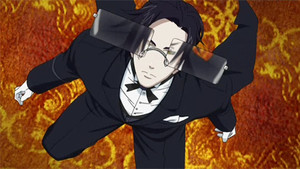
Kuroshitsuji II
Rating:
Darkness. A hint of a tune that sounds a bit like the Habanera from Carmen. A bruised, naked boy in a bed with an old, sleeping, and also naked man makes a pact with a spider, its seal branding itself on his tongue.
Apparently A-1 Pictures and director Hirofumi Ogura (who did not direct the first Kuroshitsuji anime) decided that the series needed more slashability for the BL fangirls.
For those who haven't already read ahead on Wikipedia or elsewhere, Ogura also manages to pull off something pretty impressive in the episode which will doubtless please established Kuroshitsuji fans. It will probably be less intriguing for those who are new to the franchise; nonetheless, everyone should watch all the way to the end, after the ending theme.
The episode has strong production values, and Nana Mizuki performs the role of newly-made young master Alois admirably; he is impressively obnoxious but ultimately pitiable (as he's intended to be).
Would-be fans of Kuroshitsuji should probably read some of the manga or watch the first season to get an idea of what's going on in II before watching, but if you don't have time, it's reasonably approachable without research- but you may find that you want to catch up immediately afterwards.
Kuroshitsuji II is available streaming at Funimation
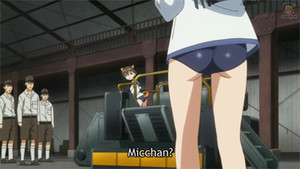
Strike Witches 2
Rating:
It becomes increasingly clear throughout the duration of the first episode of Strike Witches 2- more so than with the first episode of the first Strike Witches TV season, which is all of the franchise that I've watched -that this is some guy's very specific fantasy. It's the chance to do World War II over again but with cuter fighters and better enemies, set in a world where all the young girls are pretty and all the girls who aren't pretty are old. A world where all the men are completely generic so you don't have to look at them much. A world where all of those pretty girls are nice, funny, and can sprout animal ears and tails at will. A world where each pretty girl's nether regions are clothed in an overly-tight and shiny pair of panties or bloomers. A world, of course, with no pants, unless you're old and/or male.
A viewer's enjoyment of Strike Witches has everything to do with their reaction to that fantasy. They might find it funny- and it is pretty ridiculous -or even consider their enjoyment of it "ironic". Maybe they find that it overlaps somewhat with they own fantasies. Maybe they find such depictions of little girls horrifying, and not without some good reason. And then there's my camp: I don't get it.
Maybe it's just because this was the first episode, which revolves around suckering one Yoshika Miyafuji back into the army, but I didn't find any of it funny, nor attractive, nor horrifying. I imagine that this is what it must be like for non-anime fans to sit down and watch something like Genshiken: it's just not my world. Actually, at times it's so ridiculous it almost makes me think of Genshiken's show-within-a-show, Kujibiki Unbalance- but I don't think I'll be interested in watching enough of Strike Witches to legitimately guess at whether it's a satire.
If you had a reason for avoiding the first Strike Witches season, that reason will assuredly apply to the second. Similarly, if you loved the first season, the second promises so far to be a strong continuation, with pretty high production values as far as I can tell. (Clearly they saved money by using the same design for all unnamed male military characters.)
As for those of you who just never got around to Strike Witches season one and are curious about it, well, think of your reaction to the description above, match it to one of the groups below that, and act accordingly.
Strike Witches 2 is currently available streaming at Crunchyroll

Digimon Xros Wars
Rating:
Disclosure: I haven't seen any Digimon since the original series on Fox Kids.
Taiki Kudou is a kid with a hero complex and impressive natural athletic ability. So, naturally, when he hears a strange voice proclaim that it's dying, he runs around like a maniac trying to save it, while his pal Akari and his wannabe rival Zenjirou watch the chaos around them-- the sky gets turns neon green (the universal color of "digital"?) and a car finds itself stuck partway through a wall. Taiki eventually locates an electronic signature that appears to be the voice, and a weird little handheld device appears in front of him while an old dude's voice tells him to take it and use it. (Kids: don't take electronic devices from strangers!)
It need hardly be said that Taiki and company are transported to the Digital World, where they meet Shoutmon, the formerly disembodied voice now embodied by a little mech-ish dinosaur with headphones- it's Digimon, there WILL be random headphones, goggles, etc. -and fight a battle.
There are no big surprises in the episode, but it's exactly what you'd expect from a Digimon series, no more, no less. It will doubtless feel nostalgic for many, especially since even I was able to pick out a few familiar silhouettes from past Digimon series, so fans who've seen more than I will probably catch a bit more. The animation is well-done, the characters are reasonably cute, though appropriately-named Shoutmon may get irritating over time, and Zenjirou's "I declare myself to be your rival!" bit has been overdone in other shows.
If you've never been fond of Digimon this is certainly more of the same sort of thing, so you'll probably want to skip Xros Wars. If you're looking for an entry into the franchise and can't go back to the original, though, this is probably as good a place to start as any.

Tono to Issho
Rating:
On the one hand, Tono to Issho is a bit of a tough sell: it's one of those oh-so-wacky comedies but its focus is in Japanese history, so if you don't know some of the basics of the Edo period you may miss out on some of the humor. On the other hand, the humor seems to be largely about taking Japan's famous historical figures and giviing them silly things to say while their (also historical) assistants play straight man...but it'll be more amusing if you've absorbed what they're referring to, whether from a history class or from other anime. There's nothing subtle about it, per se, but the first episode revolves around a joke involving a series of quotes (technically senryuu, a type of poem) by three Japanese leaders, Oda Nobunaga, Toyotomi Hideyoshi, and Tokugawa Ieyasu. Each of the three offered a suggestion about what to do if a cuckoo doesn't sing which is supposed to display each man's personality. In the episode, Date Masamune, who led Japan after these three, attempts to come up with his own cuckoo quote.
In theory you might be able to pick up on this entirely based on what the episode provides, since the quotes are shown right there in the background, but the shot is so short that viewers will likely have to pause or watch the show through twice. Also, the quotes are there but they don't explain what the whole thing is about, so you might still miss it without help.
The first episode is about 90 seconds long, including a 9-second ending theme. The animation is decidedly "made in Adobe Flash" (or whatever the kids use nowadays), but the animation required to show three people standing around talking is fairly minimal to begin with, so this isn't terribly distracting. Also, kudos to the studio for not skimping out and making Masamune SD; he's there decked out in his full outfit and even complete with his oddly modern-Japanese-boy-with-gel hair. But for the record, the character Gackt voices- Uesugi Kenshin -doesn't appear in the episode.
There will doubtless be anime fans who try to prove their superior level of Japanophile-ness by proclaiming this to be the a particularly phenomenal show; in reality, it's mildly cute if you get the references, but nothing to write home about even then.
Tono to Issho is available streaming on Crunchyroll
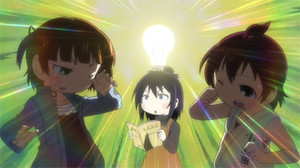
Mitsudomoe
Rating:
Imagine Kodomo no Jikan's sexually precocious trio of girls. Now imagine them completely psychotic. The triplets who star in Mitsudomoe are actually older than KnJ's, but since everyone in the show-- adults included --looks like an 8-year-old it hardly seems to matter. Hitoha is an obsessive pornographic book-reader, Futaba is an oblivious force of destruction, and Mitsuba is a sadist. In the show's defense, the girls seem to want to do good and even try to hook their teacher up with his crush, the school nurse, rather than trying to destroy his life or boink him thesmelves (mostly).
Yes, there's fanservice with these kids, largely from Mitsuba's sadistic fantasies and the occasional awkward angle. There's also some fanservice of the adults, who don't look significantly older than their charges. It's more than a little awkward, which I might be able to write off as provocative if the gags were smart or funny...but for the most part, they're not. They tend to go on too long- the episode spends most of its time on a musical chairs-esque game and a misunderstanding with a hamster named Nipples -and the characters are so simplistic that it becomes very easy to predict their reactions, which therefore aren't terribly amusing.
Without being funny the show is largely a mess of uncomfortable fanservice, stilted characters, and a couple of incredibly predictable misunderstandings. The exception to this is youngest sister Hitoha, who actually develops somewhat throughout the episode and is a book nerd to begin with, earning the show its 2.
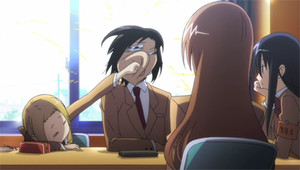
Seitokai Yakuindomo
Rating:
Tsuda is a boy living in a girls' world: a former all-girls school goes coed, and he's in the first class to allow male students. He gets drafted into the otherwise all-female student council immediately, as compensation for their making him late on the first day to straighten his tie/choke him.
What follows from that moment is a mixed bag of short comedic bits, leading the episode to feel a bit long. Some of the bits can elicit a chuckle or two, though, particularly when poking fun at the girls' misconceptions about boys as a whole. Tsuda is something of an Alice in the girls' Wonderland, playing the straight man to their over-the-top personalities, which sometimes works better than others. Fortunately the humor is fast and dirty (more on that shortly), so even the bits that don't work for you will be over quickly.
Seitokai Yakuindomo's humor is often adult in nature- a few BDSM and masturbation jokes pop up -and the ending theme makes several references to anime, marking the series as one largely aimed at anime otaku in Japan. In the first episode there were no anime-specific jokes, however, so fans won't have the occasional problem of missing references that popped up in shows like Hayate the Combat Butler. Since the humor is crude in nature, and since there is some fanservice (though not of the 16-year-old who looks 6...so far), fans seeking cleaner material will definitely want to look elsewhere. Some of the humor is slapstick, but these are usually the least effective gags. (Will Japan ever get over its fixation on making short, angry characters?)
On the other hand, there are some chuckles to be had here, although usually more because the punchlines are random non sequiturs that surprise the viewer rather than because they're clever; this is no Azumanga Daioh. Not bad for a quick and easy comedy fix, however.

Amagami SS
Rating:
Amagami SS is a visual novel adaptation. There's a guy, and he's nice, but maybe a little shy. (Actually, he starts out super emo, but fortunately that falls off pretty quickly.) And then there are a half-dozen eligible young ladies swarming around him, from the school idol to his own little sister. They're all gorgeous, smart, funny, interested in him, blah blah blah.
So, what sets Amagami apart from other visual novel adaptations? Well, our unassuming hero Junichi Tachibana spends a chunk of time in his closet, which is mildly amusing. More importantly, he actually makes a move in the very first episode-- of course, he'd have to, since this 13-episode series will reportedly cover six takes on the story, one for each girl that Tachibana might wind up with. (His sister doesn't seem to be one of them, if you wondered.)
What it appears we'll wind up with, at least for this first arc, is the basic visual novel storyline compressed into just a couple of episodes. Amagami SS impressed me by not feeling too rushed in its first episode despite providing half of popular-girl Haruka Morishima's story AND introducing the full onslaught of characters. The animation and voice acting are strong, although a couple of the character designs are too similar, leading me to mix up the characters.
In the end this first episode feels same ol' same ol', albeit with strong production values. It may be that the unusual format will allow Amagami to break out of the harem romance genre and be worth watching for those who don't usually go for that sort of thing, but if so, the first episode doesn't give much indication of it. For now it seems like a perfectly decent entry into its genre-- nothing more, nothing less.
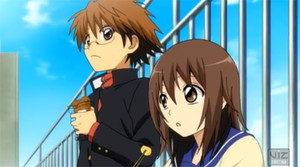
Nura: Rise of the Yokai Clan
Rating:
The first episode of Nura goes something like this: Maho Sensei Negima's Negi appears as the heir to a youkai monster clan, but wants to live as a normal human so he can hang out with his pal, Yuki (from Vampire Knight, sans vampires). Then the Harry Potter theme music plays.
Sometimes it's a cop-out to write something off as "derivative," but after 25 minutes, this show definitely feels...familiar.
In fact, even the plot line reads a little bit like last season's more adult Ichiban Ushiro no Daimaoh: Nura Rikuo, the Negi look-alike, lives with his youkai family but just wants to have a normal human life, but is burdened with a horrible destiny to become a terrifying demon leader, etc. It all sort of comes together as a show along the lines of InuYasha, Kekkaishi, and the rest of its ilk. As such the strongest moments feature the yokai themselves, and their designs and personalities are decidedly more interesting than Nura's boring human friends'.
To be fair, Nura doesn't get off to a bad start, with solid animation, okay acting, and a cute OP theme. But it just won't compare favorably to the smarter, slicker first episode of Occult Academy-- though Nura seems aimed at a slightly younger audience. If you were the kid who thought InuYasha/Harry Potter crossover fanfiction would be cool, here's your show. For the rest of us, it's probably a pass unless you really need a youkai fix.
Nura: Rise of the Youkai Clan is available streaming at VIZ Anime

Shukufuku no Campanella
Rating:
There is a chance that Shukufuku no Campanella will intrigue you to the extent that you find yourself curious about the second episode. The reason for this is that once you get beyond the inordinately long intro, featuring the vague narrations of a sleeping girl, the next 20 minutes are devoted entirely to the Oasis clan, a cast of characters that are all very nice, very sweet, and incredibly dull. Leicester is a goodie-two-shows blonde boy with a pretty maid, a sweetheart who's the darling of the vaguely European setting, and a milfy mother. Throughout the episode he and the girlfriend, Carina, befriend a puppeteer named Agnes and a swordswoman named Chelsea, and invite them and their wacky neighbors (the only characters who provide any actual amusement, mild though it is) to a party to watch a meteor shower. One of the meteor showers leads Leicester to discover a pretty young sleeping beauty.
It's funny how the story winds up centering around Leicester without giving him the slightest iota of a personality, or even more than a dozen lines. The remaining characters-- all female, of course, since this is an adult game adaptation --are all bland as can be, the only exceptions being the aforementioned sisters, who aren't so much interesting characters as just kind of weird and a slight relief from the boredom. Even the character designs are less attractive than they are overdone with bells and whistles. Every single character, Leicester included, has a wacky pair of earrings, excepting only the milf.
Viewers who find these characters charmless will wonder why the hell we're following them around for so long; the episode is primarily lengthy introductions that still fail to develop or spark any interest in the characters. The plot, such as it is, doesn't appear except quite literally as a part of the end credits. There's also a brief, perhaps 2-minute chunk of the series where it becomes fanservicey before everyone goes back to being prim, proper, and nicey-nice.
In all fairness, the show has a decent voice cast. Beyond that, however, the episode's a snoozefest unless you're really into cloyingly sweet girls.
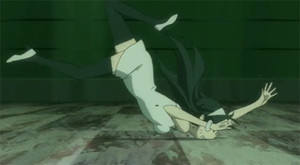
Occult Academy
Rating:
Whatever you're expecting out of Occult Academy, the first episode will probably surprise you. The series' focus is Maya-- the young woman sitting on the back of a boy on all fours in the promotional imagery. As you might expect, Maya is a girl of little patience, but the role she plays in this first episode is unexpected. The boy in the image barely appears, much less to be her unexperienced lackey; instead, Maya is the character who is embarrassed and wrong-footed throughout the episode, while still being a strong and determined character rather than an oblivious klutz. An unusual female lead these days, to be sure.
Maya's father built and acted as principal of a school that came to be nicknamed "Occult Academy". When he died, Maya arrived to sit impatiently at his funeral, only for the principal's dying message to unintentionally summon a spirit that wreaks havoc. A flustered Maya declares it to be a hoax but winds up investigating the paranormal activity anyway.
All in all the episode is strongly animated (handled with flair by A1 Pictures) and surprising in content, which in and of itself may set it apart from the rest of the season.
Occult Academy is currently available streaming at Crunchyroll
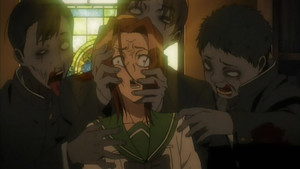
High School of the Dead
Rating:
Highschool of the Dead pulls no punches, launching its tale in the middle of a zombie invasion, with normal high school student Takashi, his childhood friend/crush Rei, and her boyfriend Hisashi fighting off and fleeing from the undead that have invaded their otherwise perfectly normal school. (Perfectly normal for an action anime, that is, which means that it included among its scholastic requirements the possession of DD-cup or larger breasts, preferably rather bullet-shaped.)
So far the main disappointment of the show is the lack of that urgent need to kick up the action a notch or ten and surprise the viewer. Black Lagoon is a series that always manages to pull this off; Hellsing long since mastered it. This can probably be forgiven since the episode focuses primarily on introducing the three main characters, and providing the briefest of glimpses of characters who will doubtless become important later. Of secondary disappointment is the fact that pretty much all of the best moments of episode one also appeared in the trailer. Tertiary: the lack of humor in the episode may make the gratuitous pantyshots and boob jiggling more awkward than sexy for some.
As for the rest, it's entertaining, if expected: decent but not fantastic animation, good but not great fight scenes, an okay but not very innovative plotline. Fans of action- and fanservice-filled zombie apocalypse titles don't need to read this to know they'll want to watch it; for those sitting on the fence, there's no sign so far that the show will be a particularly outstanding example of its genre, but it certainly delivers what its trailer promises.
High School of the Dead is currently available streaming at The Anime Network

Okami-san to Shichinin no Nakama-tachi
Rating:
One must give credit to Okami-san about one thing (and perhaps one thing only): the character designer for the original light novels, illustrator Unaji, managed to come up with yet another variation on the female high school uniform, and a rather attractive one at that. And that is likely the last of the unique qualities of Okami-san, whose first episode introduces a cast of colorful, largely single-trait characters who are members of a "Mutual Assistance Club" at their school.
Okami-san's first outing is a pretty lazy performance: characters are introduced entirely by their single traits-- a tsundere fighter girl, a scopophobic boy (that's "fear of people looking at you"), a maid with a fetish for favor-returning, whatever that means --and then propelled into a short story that exists more to establish setting than to tell us why we care about these particular kids. Exposition is provided by a narrator who is more obnoxious than any of the characters, both in vocal quality and in her jokes, including an ongoing "the main character is flat-chested!" gag that hasn't been funny since the original season of Slayers (if then).
It should be said that while the execution of this first episode was mediocre at best, there is certainly potential for the show to improve; it will never aim to be more than light summer entertainment, but it may yet succeed at that. If you bother to watch the first episode, be sure to stick around for the bit after the ending theme, which is more amusing than any of the main story. But if you skip this show, you're unlikely to miss anything you haven't seen elsewhere.
discuss this in the forum (349 posts) |
this article has been modified since it was originally posted; see change history
back to The Summer 2010 Anime Preview Guide
Season Preview Guide homepage / archives